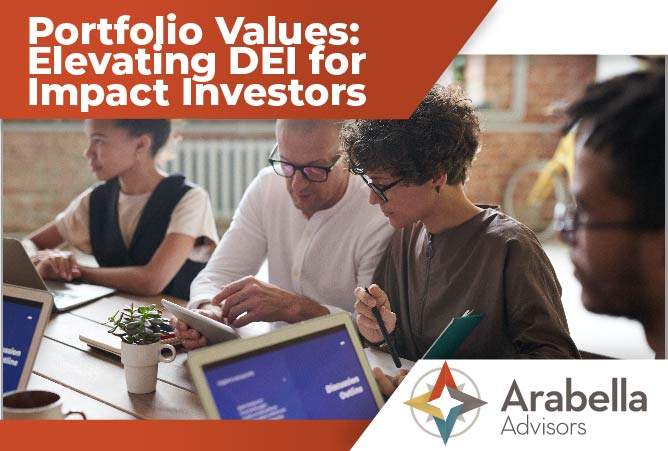Portfolio Values: Elevating DEI for Impact Investors

It has now been two years since the murder of George Floyd in the summer of 2020, which served as the catalyst to propel the issues of diversity, equity, and inclusion (DEI) from more progressive corners of public discourse to part of the mainstream conversation. At Arabella Advisors, I am proud to say that I consider our approach and perspective to DEI to be highly thoughtful and among the most comprehensive in the industry. We have spent considerable time and energy reflecting on our how DEI fits into our internal processes, such as staffing and procurement, and how we can and must incorporate DEI into our work with clients as their trusted advisors.
Much of the work Arabella does is at the intersection of philanthropic advising and implementation. For many of our clients, this means helping them design a new grantmaking strategy or build a portfolio of grantees, and we have built an impressive toolkit of techniques to incorporate DEI into those practices.
But as the head of our impact investing work, I continue to search for clear industry best practices for incorporating DEI into an impact investing engagement (or an investment portfolio overall). The impact investing industry still struggles to reach consensus on best practices on many topics—DEI included.
Our most successful client experiences occur when clients are open and honest about what they understand about DEI and how the imbalance of systemic biases affect their investment portfolios. From there, we discuss several techniques the client could use to add DEI considerations to their impact investing work. Some of the more compelling tactics we help our clients use, and that we encourage others to use as well, include:
- Reflecting on an existing portfolio. Even the most experienced impact investors need to consider how DEI dynamics have or have not manifested in their portfolios. A client hired us to help evaluate their past nearly 20 years of impact investing for efficacy and alignment with the client’s current mission and general best practices in the field. During our review, we uncovered significant funding differences across the client’s investees. We found that this client—a highly progressive investor—had been making smaller allocations to investees of color for years. This important reflection allowed the client to adjust their due diligence process to try to prevent the same biases that led to the original imbalance from reoccurring.
- Establishing diverse manager goals. We have seen clients that are intent on supporting more diverse (by gender and race) investment managers. To execute this, some of our clients have set time-bound goals. For example, one client established a plan to have a person of color, or an investment firm led by a person of color, manage a certain percentage of its portfolio by 2025. Further, it has now institutionalized examining the diversity of its managers as an ongoing practice.
- Acknowledge DEI in all memos. We include a DEI section in every due diligence memo we write. In this section, we acknowledge and discuss the diversity of the management team and advisors. Importantly, we also detail how the potential investment company plans to incorporate DEI into its operating model.
We believe it is important for all investors to adopt some or all of these techniques to advance more equitable capital markets. Through our own actions, we also strive to set a new standard in how investment decisions are made. Our hope is that by asking entrepreneurs or fund managers we are analyzing about their DEI perspective, we set the bar of expectations for other investors, who will themselves be interested in how a portfolio’s investment accounts for DEI. The more impact investors take this approach, like our clients do, the more this will become standard practice for all entrepreneurs.
We still have a lot more work to do, but I love that we’re doing it. And we love that our clients want to do more.
